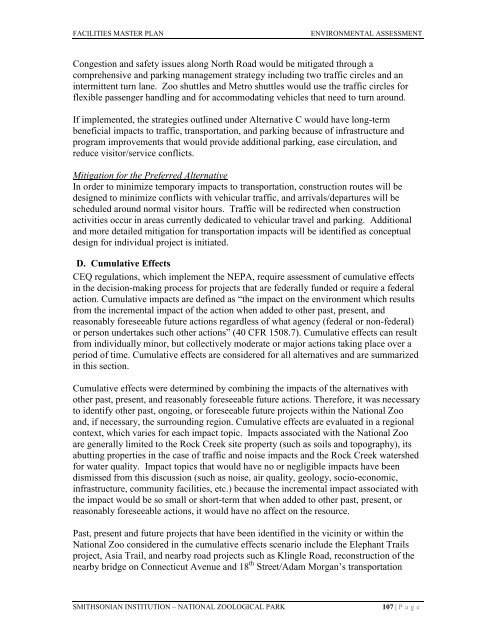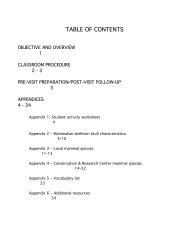facilities renewal master plan - National Zoo - Smithsonian Institution
facilities renewal master plan - National Zoo - Smithsonian Institution
facilities renewal master plan - National Zoo - Smithsonian Institution
Create successful ePaper yourself
Turn your PDF publications into a flip-book with our unique Google optimized e-Paper software.
FACILITIES MASTER PLAN ENVIRONMENTAL ASSESSMENT<br />
Congestion and safety issues along North Road would be mitigated through a<br />
comprehensive and parking management strategy including two traffic circles and an<br />
intermittent turn lane. <strong>Zoo</strong> shuttles and Metro shuttles would use the traffic circles for<br />
flexible passenger handling and for accommodating vehicles that need to turn around.<br />
If implemented, the strategies outlined under Alternative C would have long-term<br />
beneficial impacts to traffic, transportation, and parking because of infrastructure and<br />
program improvements that would provide additional parking, ease circulation, and<br />
reduce visitor/service conflicts.<br />
Mitigation for the Preferred Alternative<br />
In order to minimize temporary impacts to transportation, construction routes will be<br />
designed to minimize conflicts with vehicular traffic, and arrivals/departures will be<br />
scheduled around normal visitor hours. Traffic will be redirected when construction<br />
activities occur in areas currently dedicated to vehicular travel and parking. Additional<br />
and more detailed mitigation for transportation impacts will be identified as conceptual<br />
design for individual project is initiated.<br />
D. Cumulative Effects<br />
CEQ regulations, which implement the NEPA, require assessment of cumulative effects<br />
in the decision-making process for projects that are federally funded or require a federal<br />
action. Cumulative impacts are defined as “the impact on the environment which results<br />
from the incremental impact of the action when added to other past, present, and<br />
reasonably foreseeable future actions regardless of what agency (federal or non-federal)<br />
or person undertakes such other actions” (40 CFR 1508.7). Cumulative effects can result<br />
from individually minor, but collectively moderate or major actions taking place over a<br />
period of time. Cumulative effects are considered for all alternatives and are summarized<br />
in this section.<br />
Cumulative effects were determined by combining the impacts of the alternatives with<br />
other past, present, and reasonably foreseeable future actions. Therefore, it was necessary<br />
to identify other past, ongoing, or foreseeable future projects within the <strong>National</strong> <strong>Zoo</strong><br />
and, if necessary, the surrounding region. Cumulative effects are evaluated in a regional<br />
context, which varies for each impact topic. Impacts associated with the <strong>National</strong> <strong>Zoo</strong><br />
are generally limited to the Rock Creek site property (such as soils and topography), its<br />
abutting properties in the case of traffic and noise impacts and the Rock Creek watershed<br />
for water quality. Impact topics that would have no or negligible impacts have been<br />
dismissed from this discussion (such as noise, air quality, geology, socio-economic,<br />
infrastructure, community <strong>facilities</strong>, etc.) because the incremental impact associated with<br />
the impact would be so small or short-term that when added to other past, present, or<br />
reasonably foreseeable actions, it would have no affect on the resource.<br />
Past, present and future projects that have been identified in the vicinity or within the<br />
<strong>National</strong> <strong>Zoo</strong> considered in the cumulative effects scenario include the Elephant Trails<br />
project, Asia Trail, and nearby road projects such as Klingle Road, reconstruction of the<br />
nearby bridge on Connecticut Avenue and 18 th Street/Adam Morgan’s transportation<br />
SMITHSONIAN INSTITUTION – NATIONAL ZOOLOGICAL PARK 107 | P a g e

















